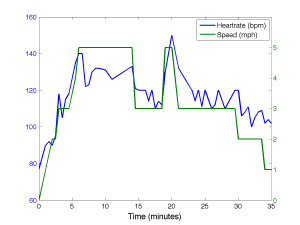Be still my beating heart
March 3rd, 2010 at 8:07 pm (Exercise)
My hotel presented me with the opportunity to collect some data about myself. On Monday, I went down to try out their exercise room and spent a while running on a treadmill (the first time I’ve ever used a hotel’s exercise room!). After a while I noticed that the shiny metal bars on the hand-rail actually were designed to measure and report your heartrate. After playing with this a little, of course I started to wonder how my body’s heartrate responded to the speed at which I was jogging.
So today when I went down for some exercise, I also took paper and pen with me. Of course what I wanted was for the machine to continuously record timestamps, speed, and heartrate and to deliver a printout to me at the end (or better, just email me the results). But no such luck, so I had to resort to recording it myself. This turned out to be more awkward than I anticipated; I wanted to record heartrate every 30 seconds, but the machine took 15 seconds just to calculate it, and then I had to fumble and write while jogging. Plus, especially at higher heartrates (or jogging speeds, not sure which was the problem), the machine would report garbage that masqueraded as a real heartrate (like suddenly dropping from 120 to 77 bpm). So in the end I had to do some data cleaning, which always makes me uneasy. But I only removed the obvious outliers and left the rest of the noise in.
The result is surprisingly sensible:

The heartrate values at about 8-15 minutes are not reliable; the machine kept reading low, and an independent test with my jugular and the wall clock suggested I was closer to 150 bpm at that point. (The 150 bpm point at 20 minutes was also from a hand-measurement.) But still, pretty cool! A bit of hysteresis, as you might expect. According to the machine, I burned 196 calories (but it didn’t ask for my weight or mass, so…) and traveled 1.9 miles. And I got to make a graph!
Katie said,
March 3, 2010 at 9:36 pm
Fun! I have never used a hotel’s exercise room, either. Interesting, too, your graph – it IS more sensible than I would have thought, since it took a while to register. Might be easier in the future with a digital voice recorder, a wristwatch-style heartrate monitor, and a real run. Then you wouldn’t have to pause to write. :)
Matthew Riddle said,
March 3, 2010 at 9:41 pm
You might like the idea of this:
http://www.tuaw.com/2010/01/26/found-footage-iphone-arduino-heartrate-monitor-humanapi/
For me this sort of thing would be great — if I could go for a run and quickly and easily look back at how much effort I had expended at each stage, it would be great!! I normally have my iPhone strapped to my arm anyway to do interval training and listen to music.
Marcy said,
March 3, 2010 at 10:11 pm
You’re awesome!
jim said,
March 3, 2010 at 10:42 pm
Oh, there are so many bits of data you can record with these things! If you do any kind of hiking or biking, it’s very handy to have a unit that records ascent and speed, letting you produce nifty graphs like this:
http://www.jimcarson.com/i/tdb_hrm.jpg
(This is from my ancient Polar HRM; I currently have a Garmin Edge 305.)
The sport units have a transmitter in a chest strap [or bra for women-folk]. The receiver is mounted on handlebars or worn on your arm like an iPod. The beauty is it’s much start and forget while you work out.
Data can be transferred to the computer for analysis. Polar’s software does a nicer job of data smoothing than Garmin’s free software. There are also third-party utilities – some free – that will read the data.
wkiri said,
March 4, 2010 at 7:23 am
Thanks for the comments and tips!
Matt, the “Human API” solution is pretty awesome. You might be able to get some info without additional hardware already — it seems likely that there is an iPhone pedometer app out there that might at least save data for later use (the Nano comes with a pedometer app already, presumably because they anticipate so many users listening to music while walking or running — but I don’t know if it records it or just shows a running total).
Jim, we actually used a chest-strap heartrate monitor while at MDRS (that was connected to a GPS-enabled watch, which gave us ground tracks), and it was interesting to compare that with our elevation changes, as in your biking example. :)
Matthew Riddle said,
March 4, 2010 at 3:47 pm
Yeah! There are even heart rate monitor apps — based on using a mic or tapping out your own heart beat. But from what I understand, you really need some additional hardware to give an accurate heart rate. The pedometer solution is okay, but I much prefer GPS tracking, which I already use with iRunner. Very accurate, and very simple.